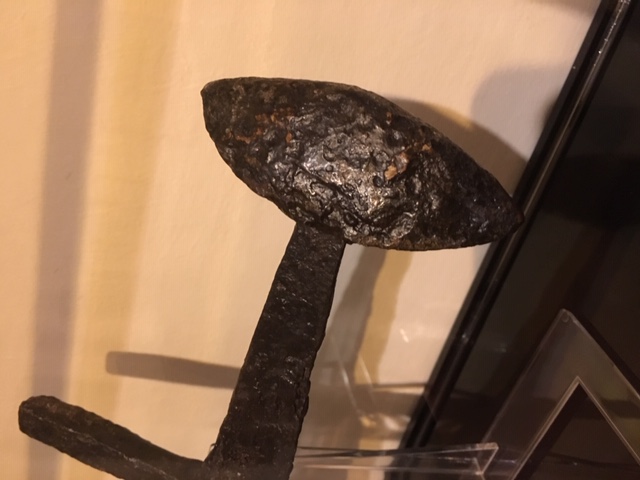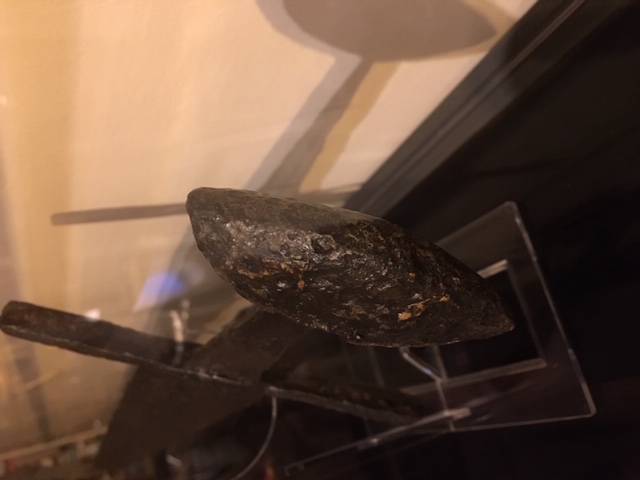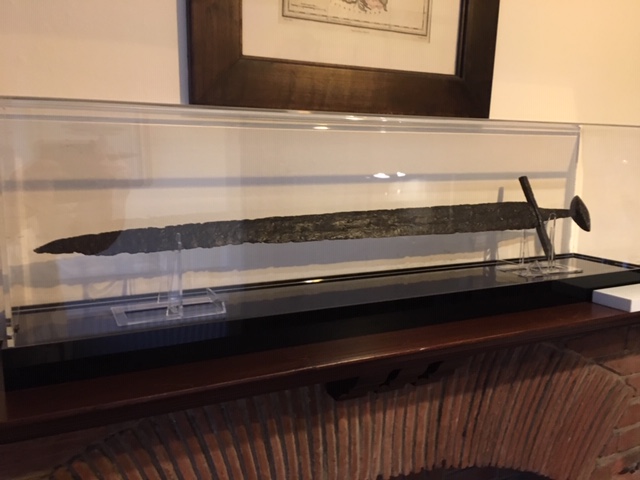| Author |
Message |
|
Jeremy V. Krause
|
 Posted: Tue 26 Feb, 2019 7:41 am Post subject: Peening on brazil nut pommels Posted: Tue 26 Feb, 2019 7:41 am Post subject: Peening on brazil nut pommels |
 |
|
Hi everyone,
We don't always get a good look at the appearance of the peening on swords in photographs.
I am interested in what folks know about how the peening was finished in brazil nut (and tea cozy) pommels.
We see some reproductions (like Albion's) who seek to blend the peen-end into the pommel and others who leave the end of the peen.
I've even seen two high end makers reproducing the St. Maurice of Turin sword finish the peen differently when both are seemingly trying to faithfully recreate the original.
What was done historically? I am guessing both were but am not sure.
Thanks for your help!
|
|
  |
 |
Michael P. Smith

|
 Posted: Tue 26 Feb, 2019 8:38 am Post subject: Posted: Tue 26 Feb, 2019 8:38 am Post subject: |
 |
|
Do you mean blended, or fairly obvious? I mean, it seems clear that peen blocks were not used (at least not commonly).
The photos of brazil nut swords I have seem to show a smooth profile, but we aren't typically shown the peen. My guess is that blended would be most usual, but that's just based on examination of photos that do not show a proud peen.
Hopefully, someone fortunate enough to have inspected some in person can confirm or deny that.
|
|
  |
 |
Maciej K.
Industry Professional

|
 Posted: Wed 27 Feb, 2019 1:42 am Post subject: Posted: Wed 27 Feb, 2019 1:42 am Post subject: |
 |
|
Mostly, on brasil nut pommels, we will find flattened and small ends, almost leveled with the surface of the pommel`s top.
However it will also depends on the smith`s style and the pommel shape.
We can say these types are peened flat, for the most of the cases and comparing with later pommels.
You can find many pictures showing this detail in web, incl. St Maurice from Turin sword.
Medieval Swords - www.artofswordmaking.com
|
|
   |
 |
|
Jeremy V. Krause
|
 Posted: Wed 27 Feb, 2019 5:00 am Post subject: Posted: Wed 27 Feb, 2019 5:00 am Post subject: |
 |
|
| Maciej K. wrote: | Mostly, on brasil nut pommels, we will find flattened and small ends, almost leveled with the surface of the pommel`s top.
However it will also depends on the smith`s style and the pommel shape.
We can say these types are peened flat, for the most of the cases and comparing with later pommels.
You can find many pictures showing this detail in web, incl. St Maurice from Turin sword. |
Hi Maciej
So you are saying we would not normally see a small “button” of the pommel end. It would have been blended into the surface of the pommel?
|
|
  |
 |
Maciej K.
Industry Professional

|
 Posted: Wed 27 Feb, 2019 9:14 am Post subject: Posted: Wed 27 Feb, 2019 9:14 am Post subject: |
 |
|
It is not a rule, but for the most of them we will not see it.
check attachment please. that one is from MAAS, Australia, ca. 1050.
... and they mostly look like this.
 Attachment: 135.35 KB Attachment: 135.35 KB
[ Download ]
Medieval Swords - www.artofswordmaking.com
|
|
   |
 |
Kai Lawson

|
 Posted: Wed 27 Feb, 2019 8:09 pm Post subject: Posted: Wed 27 Feb, 2019 8:09 pm Post subject: |
 |
|
That’s a lovely pommel! Thank you for sharing that.
"And they crossed swords."
--William Goldman, alias S. Morgenstern
|
|
  |
 |
|
Andrew Gill
|
 Posted: Thu 28 Feb, 2019 2:50 am Post subject: Posted: Thu 28 Feb, 2019 2:50 am Post subject: |
 |
|
|
The historical examples which I've seen in person (in the Kelvingrove in Scotland, mostly) and the photos I've seen all had the peen "blended" - hammered or filed down to the point where it was nearly indistinguishable from the curve of the pommel (usually only distinguishable at all because of corrosion, in fact). There may be counter-examples that I'm not aware of, of course.
|
|
  |
 |
|
Jeremy V. Krause
|
 Posted: Thu 28 Feb, 2019 1:21 pm Post subject: Posted: Thu 28 Feb, 2019 1:21 pm Post subject: |
 |
|
Thanks everyone,
It sounds like the consensus is that the peen was finished in such a way to make it largely indistinguishable from the rest of the pommel's surface.
This is good to know and may show that some manufacturers may be incorrectly finishing this detail.
|
|
  |
 |
Craig Peters

|
 Posted: Thu 28 Feb, 2019 11:13 pm Post subject: Posted: Thu 28 Feb, 2019 11:13 pm Post subject: |
 |
|
Jeremy,
Here's a photo I took of a sword kept in the Germanisches Nationalmuseum in Nürnberg. You can see that the peen is not entirely flush, and the seam is visible.
 Attachment: 917.01 KB Attachment: 917.01 KB
[ Download ]
|
|
  |
 |
|
Jeremy V. Krause
|
 Posted: Fri 01 Mar, 2019 7:18 am Post subject: Posted: Fri 01 Mar, 2019 7:18 am Post subject: |
 |
|
Thanks Craig,
So on the photo we see an example with a more visible seem so the finishing to the point of near invisibility must not be the hard and fast rule.
Thanks!
|
|
  |
 |
J.D. Crawford

|
 Posted: Fri 01 Mar, 2019 1:28 pm Post subject: Posted: Fri 01 Mar, 2019 1:28 pm Post subject: |
 |
|
|
As discussed off-line with Jeremy, I also prefer the blended look whenever possible. But its hard to get craftsmen and artists to follow rules. I doubt that has changed since the first cave drawing.
|
|
   |
 |
Michael Harley

Location: Melbourne, Australia Joined: 12 Apr 2006
Posts: 94
|
 Posted: Sat 02 Mar, 2019 3:55 pm Post subject: Posted: Sat 02 Mar, 2019 3:55 pm Post subject: |
 |
|
| Maciej K. wrote: | It is not a rule, but for the most of them we will not see it.
check attachment please. that one is from MAAS, Australia, ca. 1050.
... and they mostly look like this. |
Just to clarify, currently housed in the Museum of Applied Arts and Sciences in Australia, object number H6923, found in England.
Information is not knowledge, Knowledge is not wisdom, Wisdom is not truth - Frank Zappa
|
|
   |
 |
Craig Peters

|
 Posted: Sat 02 Mar, 2019 9:11 pm Post subject: Posted: Sat 02 Mar, 2019 9:11 pm Post subject: |
 |
|
|
On some Brazil nut pommels, we see the tang protruding through the top of the pommel. Is this merely a result of age and degredation, with the pommel slipping down the tang? Or are there some instances of proto-peen block?
|
|
  |
 |
Daniel Parry

|
 Posted: Sat 23 Mar, 2019 5:58 pm Post subject: Posted: Sat 23 Mar, 2019 5:58 pm Post subject: |
 |
|
The example I have. The peening is almost invisible but if you angle the light right, you can see a slight difference in the centre of the pommel that may be the peening end,
 Attachment: 78.33 KB Attachment: 78.33 KB

 Attachment: 63.99 KB Attachment: 63.99 KB

 Attachment: 78.04 KB Attachment: 78.04 KB

|
|
  |
 |
Craig Peters

|
 Posted: Thu 30 May, 2019 10:10 pm Post subject: Posted: Thu 30 May, 2019 10:10 pm Post subject: |
 |
|
Here's another example of a sword that does not have a peen flush with the pommel, but instead slightly protrudes. You'll have to look closely to see it.
 Attachment: 9.4 KB Attachment: 9.4 KB

|
|
  |
 |
|
|

